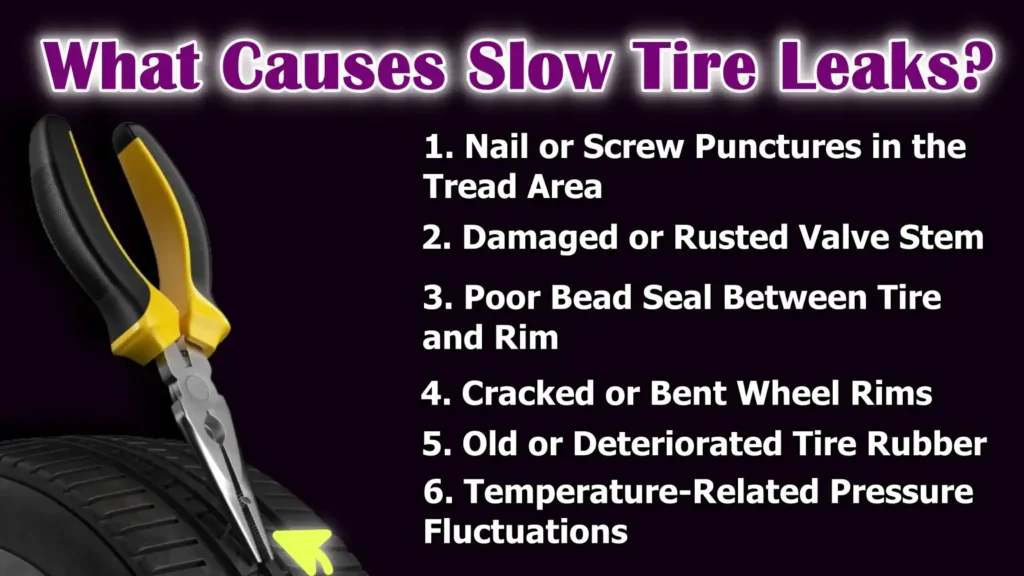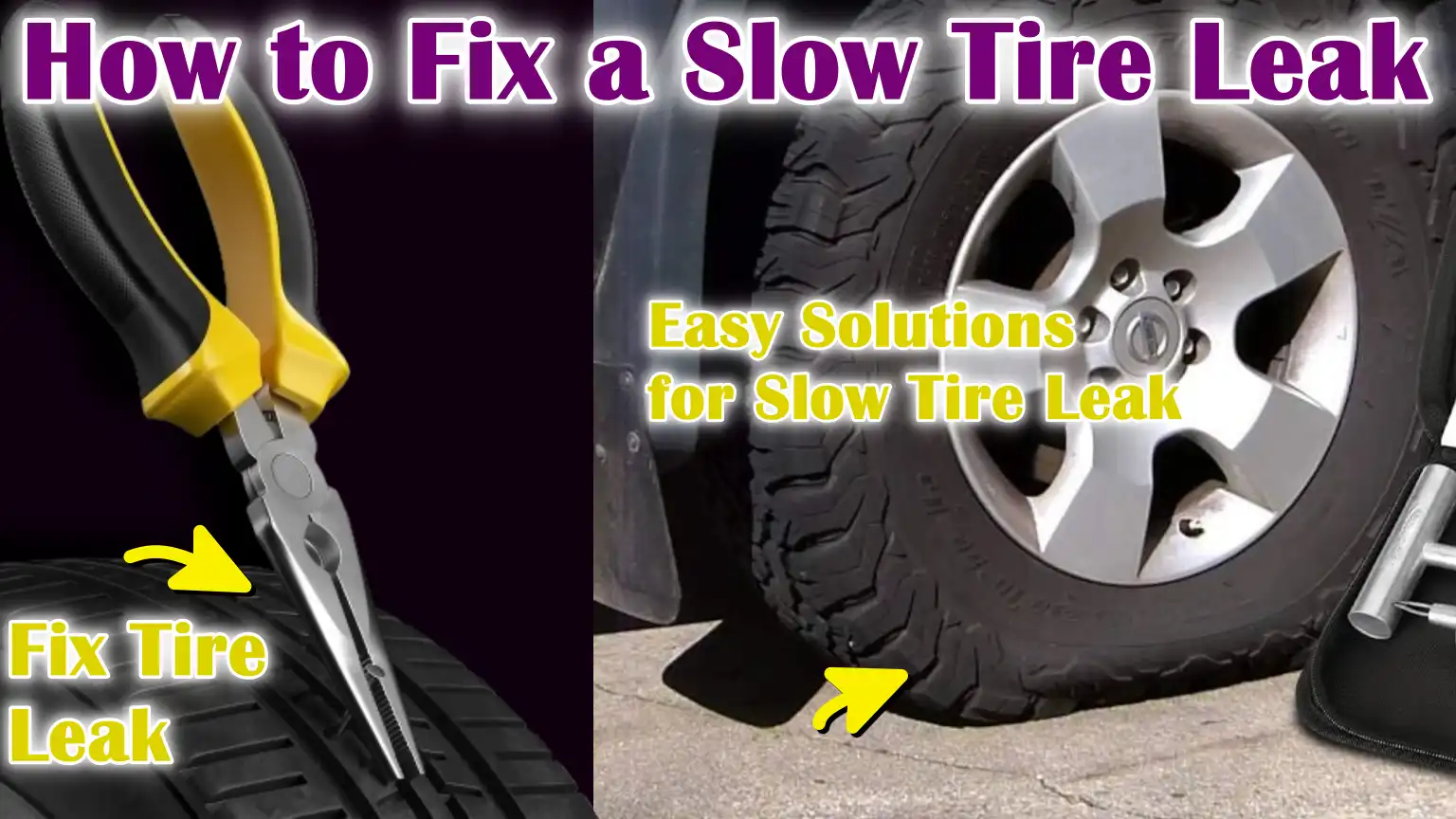Written By: Don Dodi
Fact Checked By: Kristen Brown
Reviewed By: Diego Rosenberg
It is the undeniable fact that even a minor tire leak can cause your car to burn more fuel and wear out its tires rapidly.
Yes, most of the time tires actually losses pressure naturally but if you’re feeling that you have to refill your tires rapidly or more frequently than ever, then it might be because of the external factors such as: tiny puncture or loose valve steam that even can cause a tire to lose one to three pounds of pressure every month.
Basically, this gradual air loss may actually seems harmless and won’t be that problematic but it can reduce fuel efficiency, it even leads to the poor handling, uneven tire wear and even you can face sudden tire failure.
Plus, NHTSA also reports that underinflated tires are actually factor in the thousands of crashes each year as they increases braking distance and heat buildup is also the reason behind their dangerous acts.
This guide is actually tells you everything about How to Fix a Slow Tire Leak, as it has really simple checks such as: using soapy water to find bubbles, then you need to inspect the valve stem or you need to apply a plug or sealant, so you can see these are really simple things that you can perform even at home with just basic tools.
What Causes Slow Tire Leaks?

1. Nail or Screw Punctures in the Tread Area
One of the most common causes of slow tire leaks is a small puncture caused by a nail, screw, or sharp debris lying on the road.
These objects often pierce the tire tread at a slight angle, creating a small hole through which air slowly escapes.
Unlike sudden punctures, these punctures are not immediately visible because the tire gradually loses pressure over several days or weeks.
Driving on rough roads or in construction zones increases the risk of such punctures, so regular tire inspection is essential.
2. Damaged or Rusted Valve Stem
The valve stem is the small rubber or metal piece where you fill the tire with air.
Over time, the valve stem can crack, wear, or rust, causing air to slowly leak.
This type of leak is difficult to detect because it often occurs without visible damage to the tire.
Bad weather, road salt exposure and age are common causes of valve stem failure.
3. Poor Bead Seal Between Tire and Rim
The bead is the edge of the tire that tightly attaches to the wheel rim.
If the bead seal is not properly formed due to dirt, rust, or improper installation, air can slowly escape around the rim.
Poor bead sealing often occurs when tires are installed incorrectly or there is minor damage to the rim and this can lead to uneven tire pressure, affecting vehicle handling.
4. Cracked or Bent Wheel Rims
Cracks, bends, or corrosion on the wheel rim can create small gaps through which air can slowly escape.
Minor damage to the rim from potholes, cracks, or road debris can also cause a gradual leak.
Although the tire itself may appear fine, a damaged rim seal prevents it from remaining strong, so it’s important to inspect the rim for any slow leaks.
5. Old or Deteriorated Tire Rubber
As tires age, the rubber naturally deteriorates, becoming brittle and developing small cracks.
These cracks, often along the sidewall or tread, allow air to slowly leak out.
Tires older than six years are more vulnerable, even if their tread appears to be in good condition.
Therefore, regular tire age and condition checks are essential.
6. Temperature-Related Pressure Fluctuations
Normal changes can cause tire pressure to increase or decrease, sometimes leading to a slow leak.
Cold weather compresses the air inside the tire, while warm weather expands it.
If a tire is already slightly damaged or underinflated, these fluctuations can exacerbate air loss, making a gradual leak more noticeable during seasonal changes.
Basic Signs and Symptoms of a Slow Tire Leak
1. Intermittently Illuminating the Tire Pressure Warning Light
One of the earliest signs of a slow tire leak is the Tire Pressure Monitoring System (TPMS) warning light on your dashboard.
This light flashes and blinks intermittently as your tires gradually lose air.
Modern vehicles use sensors to detect a drop in pressure and even a few pounds of low pressure can trigger a warning.
Ignoring this light can cause your tires to become underinflated, leading to uneven wear and increased risk of tire failure.
2. Slight Pull to One Side
Low tire pressure can cause your vehicle to pull slightly to one side while driving.
This occurs because a low-inflated tire is unable to fully contact the road, affecting the vehicle’s balance and alignment.
Drivers may notice a slight steering tilt or uneven handling, specially when braking or cornering, which is a clear sign that tire pressure should be checked immediately.
3. Reduced Fuel Efficiency
Slow leaks can reduce fuel efficiency because under-inflated tires create more rolling resistance.
According to the U.S. Department of Energy, under-inflated tires can reduce fuel mileage by up to 3%, meaning your car consumes more fuel to maintain the same speed.
Over time, this not only increases fuel costs but also puts unnecessary strain on the engine and tires.
4. Noticeable Deflation Over a Few Days
Slow leaks often appear when tire pressure gradually drops over several days.
Regularly checking tire pressure with a gauge can detect this pattern.
Even a drop of 1-2 pounds per week could indicate a small puncture or valve problem.
Catching it early can prevent further deflation, which could lead to unsafe driving conditions or a sudden tire failure.
5. Hissing or bubbling when testing with soapy water
A practical way to detect a slow leak is to listen for a slight hissing sound or test with plain soapy water.
Spraying soapy water on the tire’s tread, sidewall, valve stem and bead area will cause bubbles to form at the leak.
This method is extremely effective in identifying hidden punctures, small cracks, or valve problems, allowing timely repairs before the problem escalates.
Safety First, Precautions Before You Begin
1. Park the Vehicle on a Level Surface
Before repairing a slow-moving tire, it’s important to park the vehicle on a flat and level surface.
Working on a slope increases the risk of the vehicle rolling or swaying, which could cause injury or complicate the repair.
A flat surface ensures stability when inspecting or removing the tire, allowing you to work safely and accurately.
2. Engage the Parking Brake
Always engage the parking brake before beginning tire repair.
This prevents the vehicle from unexpected movement, specially if you need to lift it with a jack.
The parking brake secures the car in place and provides an additional layer of safety, reducing the chance of accidents during the repair process.
3. If available, use wheel chocks
Using wheel chocks is an important precaution that provides additional safety.
Placing chocks in front and behind the wheels on the ground prevents the vehicle from rolling.
This is specially useful on slightly uneven surfaces or if the parking brake alone cannot fully secure the car.
4. Avoid driving long distances on a leaking tire
Driving long distances on a leaking tire at a slow speed is dangerous because the tire can deflate further while driving.
Underinflated tires generate more heat, increasing the risk of tire damage or a burst.
It is always safer to repair a leak as soon as possible rather than driving long distances with low air or waiting.
5. Wear protective gloves and eye protection
Protective equipment is essential when repairing a tire.
Wearing protective gloves prevents cuts, scratches and exposure to chemicals like tire sealant.
Eye protection protects against debris, splashes, or sudden deflation while inflating or repairing a tire.
Simple safety equipment makes the repair process safer and reduces the risk of injury.
Tools
| Tool / Material | Purpose / How It Helps | Notes / Tips |
|---|---|---|
| Tire Pressure Gauge | Measures the air pressure in your tires. | Helps you identify which tire is low on air and ensures proper inflation after repair. |
| Air Compressor or Tire Inflator | re-inflating tires. | Essential for quickly and accurately filling tires to the recommended pressure. |
| Spray Bottle with Soapy Water | Locates the exact location of the leak. | Bubbles form at the leak site, making it easier to detect hidden punctures or valve problems. |
| Tire Plug Kit or Tire Sealant | Repairs small punctures in the tread. | Plug kits are for temporary or permanent repairs, while sealants can stop a leak immediately without removing the tire. |
| Lug Wrench and Jack | Removes tires from car. | This is only needed if the tire needs to be removed for repair; make sure the jack is used on a flat, stable surface. |
| Valve Core Tool and Replacement Valve Stems | Fixes leaks in valves. | The valve core tool removes the old valve core and the replacement stem ensures a tight, leak-free seal. |
How to Fix a Slow Tire Leak – Perfect Guide
1. Check Tire Pressure and Identify the Problem Tire
The first step to fixing a slow tire leak is to measure the air pressure in all your tires using a tire pressure gauge.
This helps you identify which tire is losing air faster than others.
Maintaining the correct pressure is essential for safe driving, even tire wear and fuel efficiency.
By starting with this step, you can determine which tire needs attention before beginning repairs.
2. Check for Visible Damage
Once the problem tire is identified, inspect it carefully for any visible damage.
Look for nails, screws, glass fragments, cuts, or cracks in the tire’s tread or sidewall.
These things often create small punctures that cause slow leaks.
A thorough visual inspection helps determine whether the leak is caused by the tire, valve, or rim, which is crucial for choosing the correct repair method.
3. Soapy Water Test
The soapy water test is a simple and effective way to locate the exact location of the leak.
Mix water and soap in a spray bottle and apply it to the tire surface, the valve stem and where the tire meets the rim.
Bubbles will form where air is escaping.
This test is specially useful for detecting hidden punctures or minor leaks in the valve and bead that are not visible to the naked eye.
4. Decide on a Repair Method
After locating the leak, determine the most appropriate repair method.
Small punctures in the tread can often be repaired with a tire plug or patch; valve leaks may require replacing the valve core or stem and rim or bead leaks may require resealing.
Choosing the right method ensures a safe and long-lasting repair and restores proper tire function.
5. Repair the Leak
For tread punctures, remove any objects causing the leak, clean the hole and rim and plug using a tire repair kit according to the instructions.
If the leak is in the valve stem, replace the damaged valve or core with a new one.
If the leak is due to a poor bead seal or rim damage, clean the rim and apply bead sealer to create an airtight connection.
Proper repair ensures that the tire maintains pressure and prevents future problems.
6. Inflate the Tire to the Proper PSI
After repairing the leak, inflate the tire to the manufacturer’s recommended pressure.
This information is usually found on a sticker inside the driver’s side door or in the vehicle manual.
Correct tire pressure is crucial for vehicle safety, handling, fuel efficiency and tire life.
Using a reliable air compressor or inflator ensures accurate and consistent inflation.
7. Recheck the leak
After the tire is inflated, repeat the test with soapy water to ensure the repair has completely sealed the leak.
No bubbles indicate the tire is airtight and safe to use.
Rechecking ensures the repair is effective and won’t cause further air loss, giving you confidence in the tire’s performance and road safety.
When You Should Replace Tire Instead of Repair It
1. Sidewall Damage
Tires with damaged sidewalls should never be repaired because the sidewall is a critical structural component of the tire.
Cracks, deep cuts, or bulges in this area reduce the tire’s ability to maintain pressure and absorb road shocks.
Even a small puncture in the sidewall can cause a sudden tire failure while driving.
In such cases, replacing the tire completely is the safest option to prevent accidents.
2. Large Punctures or Multiple Holes
Tires with large punctures or multiple holes cannot be reliably repaired.
Most repair kits and patching methods are only effective for small punctures in the tread area, typically less than a quarter-inch in diameter.
Multiple or large holes weaken the tire’s structure, making it unsafe to drive on even after repair.
Replacement ensures proper tire strength and continued performance.
3. Excessively Rusted Rims
If the rim is excessively rusted, bent, or cracked, the tire cannot seal properly, resulting in a persistent air leak.
Repairing a tire without repairing the rim damage is often ineffective and dangerous.
In the event of excessive rim wear, it may be necessary to replace both the rim and tire for a secure and airtight fit.
4. Worn or Worn Tires Beyond the Repair Limit
Tires typically have a lifespan of approximately six to ten years, depending on use and care.
Worn tread, cracks and rubber degradation reduce a tire’s ability to hold air pressure and withstand road pressure.
Even if a slow leak is repaired, an old or worn tire may fail unexpectedly.
Replacing tires that have exceeded their safe life limit is essential for overall vehicle safety, proper handling and fuel efficiency.
Read More:
How to Prevent Future Tire Leaks
Plus, NHTSA shows that Tire Pressure Monitoring System finds out that many vehicles have at least one tire 20% or more below the placard pressure, which clearly clearly means that by just using TPMS it helps your drivers to notice pressure loss but cannot fix leaks, so you have to be really careful about it over the time and check the air pressure regularly.[¹]
1. Regularly Check Tire Pressure
Regularly monitoring tire pressure is one of the simplest and most effective ways to prevent slow leaks.
Tires naturally lose a small amount of air over time, but underinflation can cause faster wear and increase the risk of punctures.
Using a reliable tire pressure gauge at least once a month and before long trips ensures that each tire is maintained at the manufacturer’s recommended pressure, which improves safety, fuel efficiency and extends tire life.
2. Check Tires for Debris
Regularly checking tires for objects like nails, screws, glass, or small stones can help prevent slow leaks before they become serious.
Even small debris can gradually puncture the tire tread and allow air to escape.
Removing these items promptly helps maintain tire integrity and reduces the risk of a sudden tire puncture while driving.
3. Keep the valve cap tightly closed
Valve caps are a simple but often overlooked safeguard against tire leaks.
They protect the valve from dirt, dust and moisture, which can cause corrosion or damage, leading to gradual air loss.
Ensuring that the valve caps are tightly closed and in good condition provides an additional layer of protection to maintain air in the tire.
4. Avoid Potholes and Curbs
Driving carefully to avoid hitting potholes, road debris and curbs helps prevent tire and rim damage, which are common causes of slow leaks.
Sudden impacts can bend the rim, break the tire bead, or puncture the tread.
Driving carefully and being aware of road conditions reduces the risk of both slow and sudden leaks.
5. Periodically Rotate Tires and Balance Wheels
Regular tire rotation and wheel balancing distributes wear evenly across all tires, preventing weak spots where slow leaks may be more likely.
Following the manufacturer’s recommended rotation schedule, typically every 5,000 to 7,500 miles, maintains even tread wear, improves vehicle handling and increases overall tire life, reducing the likelihood of future leaks.
Basic Difference Betwen Professional Repair vs Self-Repair
1. Advantages and Limitations of Self-Repair
Self-repair can be convenient, quick and cost-effective for slow tire leaks.
Using a tire plug kit or sealant, many drivers can repair small punctures at home without visiting a shop.
This saves time and avoids immediate driving hazards.
However, self-repair has its limitations.
Repairing with a plug alone may not repair damage inside the tire and improper repair can lead to repeated leaks or unsafe driving conditions.
Self-repair is generally best suited for small tire punctures and temporary solutions, specially when immediate professional service is not available.
2. Advantages and Limitations of Professional Repair
Professional tire repair services offer a more permanent and reliable solution.
Experts can remove the tire and apply a patch from the inside, restoring the tire’s structural integrity more effectively than a plug.
Professionals also have specialized equipment to thoroughly inspect the tire, valve and rim, ensuring that hidden damage is identified and repaired.
Although professional repairs cost more and require a trip to the shop, they offer peace of mind, long-lasting results and safer driving.
Opting for professional repair is specially recommended for large punctures, multiple holes, or tires required for long-distance or high-speed driving.
Conclusion – How to Fix a Slow Tire Leak
The fact is that tires are the only one that contact between your car and the road, even this simple and single reason is enough to keep it in top condition to prevent costly repairs and accidents as well.
Even minor punctures, valve problems, or rim damage can gradually leak air, causing tires to underperform or fail unexpectedly.
By regularly checking tire pressure, checking for debris and promptly addressing leaks, drivers can prevent many problems before they become serious.
While self-repairs like plugs or sealants are convenient for minor punctures, professional repairs provide a more permanent solution by patching the tire from the inside and ensuring structural integrity.
Understanding when to repair and when to replace, combined with careful driving habits and proper tire maintenance, enables car owners to keep their vehicles safe, efficient and reliable.
Taking the time to fix a slowly leaking tire is a small effort that provides long-term safety, peace of mind and improved vehicle performance.
Now, you can comment below for more information about this guide.
Frequently Asked Questions
Q1. What is a slow tire leak?
Answer: A slow tire leak occurs when a tire gradually loses air over time, rather than a sudden puncture. This can be caused by small punctures, damaged valves, or minor rim problems. Unlike a sudden puncture, a slow leak may not be immediately noticeable, but if not addressed promptly, it can cause uneven tire wear, reduced fuel efficiency and even unsafe driving conditions. Regular tire inspections are essential for early detection of a slow leak.
Q2. How can I detect a slow tire leak?
Answer: You can detect a slow tire leak by regularly checking your tire pressure with a tire gauge. Signs include the tire pressure warning light coming on, the car leaning slightly to one side, a significant drop in air pressure over a few days, reduced fuel efficiency, or a slight hissing sound. Another easy method is to spray soapy water on the tire, valve and rim; bubbles will form where air is escaping.
Q3. Can I fix a slow tire leak myself?
Answer: Yes, small, slow leaks in the tire tread can often be repaired at home using a tire plug kit or sealant. You’ll need basic tools like a tire pressure gauge, soapy water and, if the leak is in the valve, a valve core tool. Self-repair is convenient and time-saving, but it’s usually best suited for small punctures. For larger holes, sidewall damage, or multiple leaks, professional repair is safer and more reliable.
Q4. When should I take my tire to a professional instead of repairing it myself?
Answer: If the tire has damaged sidewalls, large punctures, multiple holes, or the rim is bent or rusted, you should consult a professional. Professionals can patch the tire from the inside, which is more permanent and restores the tire’s structure. Old or very worn tires should also be replaced by a professional rather than relying on self-repair.
References:
[1] TIRE PRESSURE MONITORING SYSTEM FMVSS No. 138
https://www.nhtsa.gov/sites/nhtsa.gov/files/tirepressure-fmvss-138.pdf

Guys, I’m a car audio enthusiast and customization expert and I love clear sound and clean installation. Plus, I have spent years helping people build their dream audio setups. And whenever I’m working on cars, I probably listen to music and thinks about the next big upgrade.

